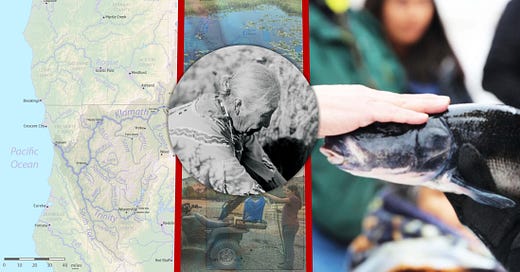Hello Interactors,
What a wild water filled week. From too much water coming too fast to not enough coming too slow, the United States is bearing witness to the schizophrenic behavior of an angry imbalanced ecosystem. Our mother earth isn’t the only one with schizophrenia. The United States, and other eco-wrecking countries, can’t decide if Indigenous people — the historical stewards of this planet — should be silenced and contained or begrudgingly ordained as the knowledge keepers and leaders of how best please our angry mother earth.
As interactors, you’re special individuals self-selected to be a part of an evolutionary journey. You’re also members of an attentive community so I welcome your participation.
Please leave your comments below or email me directly.
Now let’s go…
IN COMING
It was eight o’clock on a sunny morning when Kelly Minty Morris received a notification on her phone that read “extreme alert”. A missile was headed straight for her. This must be some mistake, she thought to herself. This was something that she didn’t think of having to deal with in her country. She and her husband were in Hawaii where he was about to compete in a 100 mile trail running endurance race called the HURT100. Missiles can bring a whole new level of hurt; but, as she looked around, to her surprise, nobody was scrambling or panicking. Not even herself. They all believed it must be some kind of blunder.
There is no mistaking that this summer has had its fair share of climate scares. The Northeast have had nothing but rain all summer. Just this week New York’s Central Park was dowsed with six inches of rain in as many hours. A once in a 500 year event.
The Northeast continues to be battered by wind and rain killing over a dozen people in its path. It’s the fallout of hurricane Ida, the fifth most severe hurricane on record, that slammed Louisiana’s coast earlier in the week but was barely phased by its landfall. Now a new hurricane is brewing as climatologists predict a 60% chance that more extreme hurricanes will follow this year.
Meanwhile, water in the west is wanting. California’s fires have claimed two million acres. Ten percent of the sequoia population was taken by a single fire; trees that have been on this planet for thousands of years – gone. It’s so dry in southern Oregon’s Klamath valley that wells are drying up. Homeowners are having to drive for their water. The county has ordered cisterns from as far away as Oklahoma, but are running up against shortages of rain barrels due to choked supply chains and increased demand.
Kelly Minty Morris sat for a half an hour, there in Hawaii, fretting. But she was more concerned with the lackadaisical response to an incoming ballistic missile than the actual damage it may inflict. “It really did feel surreal,” she said. “I wasn’t panicking, I wasn’t anxious, I wasn’t upset, my brain kept telling me, ‘This can’t be real, this can’t be real.’”1 And then it happened. Another text buzzed her phone. The alert was a mistake. A state employee had pushed the wrong button. I suspect that’s a former state employee.
Kelly left that incident reflecting on the collective apathy she witnessed. She began to wonder what it would take to get people to actually act in the face of an emergency. Upon her return home to Oregon, she vowed as a Klamath County Commissioner to put steps in place that encourage people in her area to respond appropriately to an emergency. She said, “You don’t want to be waiting for an actual emergency to then figure out what you should have done.”
KILL THE INDIAN, SAVE THE MAN
The Klamath valley has seen its fair share of emergencies, but every generation seems surprised. And sometimes apathetic. The first occupants of this area were the Klamath Tribes: the Klamath, the Modoc and the Yahooskin-Paiute people. They were sometimes referred to as mukluks or numu – the people. People, while differentiated by name, are still animals. And like our multi-legged, finned, scaled, and winged companions, we are an integral part of the environment. This was, and remains, a pan-Indigenous concept that deserves reminding. The Klamath Tribes embraced this belief in a shared communal slogan, “naanok ?ans naat sat’waYa naat ciiwapk diceew’a “We help each other; We will live good”
These people did live well. For thousands of years area bands and tribes — bound by loyalty and family — fished, hunted, farmed, and ranched the land in a perpetual act of reciprocity that respected and honored the land and its occupants. From the marshy banks of Oregon’s Klamath Lake and up the Sprague Valley, south along the rivers feeding California’s Lower Klamath Lake, across the lava beds and all the way down to Shasta Mountain, the Klamath tribes prided themselves on their industriousness.

But by the 1800s, the word industrious took on a different tenor. The industrialist fueled American imperialism swaggered on to the scene with their own slogan: No thanks, we’ll help ourselves; so that we will live good.
In 1826 The Hudson Bay Company trappers invaded Klamath territories and conflicts ensued. By 1838, the company had made maps of the region making it easier for John C. Frémont to lead an expedition into the area in 1843 as part of the country’s doctrine of Manifest Destiny.
If you’ve even been to California, you probably have seen Fremont’s name. In addition to the city of Fremont in northern California, there are dozens of streets and places that bear his name. He was a civil war general; one of four appointed by Abraham Lincoln. He was also the first nominee to run for presidential office by the Republican party. But he was decommissioned by the military in 1856 for his ‘unorthodox ways’.
Ten years prior, on April 6, 1846, Fremont massacred between 120-200 Indigenous people on the Sacramento River. A month later, May 12, 1846, led by his trusty scout Kit Carson, they raided a Klamath village killing over fourteen people. Kit Carson had been killing and scalping Indigenous people from Colorado to California for nearly twenty years by this point. His first was when he was nineteen years old in 1828.
After two decades of wars waged against the Klamath Tribes by the United States, they agreed to a treaty in 1864. In exchange for the 22 million acres these people had cared for over thousands of years and for hundreds of generations, the United States granted them the right to continue to hunt, fish, and gather within a designated 1.2 million acre reservation. Less than one tenth of their land. The treaty also included rights to the water.
Article 6 of the treaty read:
“To each head of a family shall be assigned and granted a tract of not less than forty nor more than one hundred and twenty acres, according to the number of persons in such family; and to each single man above the age of twenty-one years a tract not exceeding forty acres.”2
The treaty was ratified in 1870. With a signature at the bottom of a string of legalese I can barely understand, these people lost nearly 99 percent of their land and ancestral heritage.
The dispossession created tension between the Klamath and Modoc leading to the Modoc War between 1872-73. The Klamath, Modoc and Yahooskin people mostly remained loyal to one another; and they remained industrious. As part of the treaty, the United States agreed to provide services and support aimed at assimilating these native people into Western culture and livelihoods. Article 5 of the treaty states:
“The United States further engage to furnish and pay for the services and subsistence, for the term of fifteen years, of one superintendent of farming operations, one farmer, one blacksmith, one sawyer, one carpenter, and one wagon and plough maker, and for the term of twenty years of one physician, one miller, and two school-teachers.”3
Elders encouraged young people to learn the new ways of living and farming; including farming timber. By 1870 they constructed a lumber mill and began selling timber back to settlers. They even sold lumber to the United States to build Fort Klamath – a U.S. military outpost used to deter attacks from Indigenous people on encroaching settlers.
KILL THE TRIBES, STEAL THEIR MONEY
By the 1950s the Klamath Tribes became one of the most prosperous tribes in America. In keeping with their traditional ways, they owned, managed, and sustained the largest stand of Ponderosa Pine in the West. Driven by a self-sufficient determinism millennia old, they were the only tribe to make enough money to pay the United States Government for the services their people utilized.
But their success made them a target. The 1950s marked the beginning of the Cold War as communist paranoia swept through the United States. The reservation system the government had thrust upon Indigenous people was suddenly deemed communist. These people, and their alien ways, were seen as anti-American. Worse yet, most tribes were dependent on a central government – clear evidence of communism. This is the same central government that stole their land, attempted genocide, and forced the remaining survivors onto reservations.
America was also building highways at this time and needed land; they were selling cars and needed oil; they were building atomic bombs and needed uranium; and they needed money to fund wartime debt and nation building of countries we had destroyed or help to destroy in two World Wars.
The United States surveyed the country in search of valuable land and resources and the reservations and treaties they had invented were getting in the way. They needed that land to tax, sell, and exploit for natural resources and money. In the words of former Cheyenne Senator from Colorado, Ben Nighthorse Campbell:
“In Washington’s infinite wisdom, it was decided that tribes should no longer be tribes, never mind that they had been tribes for thousands of years.”
In 1952 the House of Representatives issued Joint Resolution 698 which called for a list of tribes to be terminated. The focus was first on tribes that had demonstrated self-sufficiency, had been adequately acculturated, and were willing to accept the termination of federal assistance.
The Klamath Tribes stood out. Having demonstrated just how profitable their land could be, it was time the United States took even more than they had a century prior.
On August 1, 1953, House Concurrent Resolution 108 was issued by the United States Congress announcing the official federal policy of termination. The resolution called for the immediate termination of the Klamath Tribes. Included were the Flathead, Menominee, Potawatomi, and Turtle Mountain Chippewa, along with all tribes in the states of California, New York, Florida, and Texas.
Between 1945 and 1960 Congress terminated more than one hundred tribes and small bands, 11,500 Indigenous people lost their native legal status, and over one million acres of land lost its trust status. Not a single tribe has improved economically since, while corporations have profited handsomely.
In 1970, President Richard Nixon – an unlikely preacher of morality and legality – issued this statement of repudiation to Congress:
“Because termination is morally and legally unacceptable, because it produces bad practical results, and because the mere threat of termination tends to discourage greater self-sufficiency among Indian groups, I am asking the Congress to pass a new Concurrent Resolution which would expressly renounce, repudiate and repeal the termination policy as expressed in House Concurrent Resolution 108 of the 83rd Congress.”
Since the end of termination, as of 2013, “78 of the 113 terminated tribes have been recognized again by the United States government and 35 now have casinos; 24 of these tribes are now considered extinct; 10 have state recognition but not federal recognition; and 31 are without land.4
GAMBLING OUR EXISTENCE
In 1974, a Federal Court ruled the right of the Klamath Tribes to their Treaty rights to hunt, fish, and gather. They also ordered that the tribe be consulted on land management matters that may infringe on their Treaty rights. In 1986 the Reagan administration restored their Federal recognition, but did not return their land. They were then asked to come up with a plan for how to remain self-sufficient if they were to remain in the area.
They were determined to honor their commitment to their ancestors who, like them, cared for the land they lived on for thousands of years. And already demonstrating their ability to coexist with colonial settlers, they also wanted to adhere to their belief, “We help each other; We will live good.” So they proposed building a casino.
In 1997, 45 years after termination, and the Reagan administration’s approval allowing tribal casinos, they opened the doors to the Kla-Mo-Ya Casino. While casinos indeed infuse money and resources into challenged tribal communities, there’s also evidence casinos lead to gambling addictions – especially among economically vulnerable residents – including aging tribal elders.
The Klamath Tribes water rights are front and center as wells run dry in the Klamath River basin. For millennia, people of the Klamath Tribes celebrated the return of fish in the spring after long harsh winters had drained their food supplies. Two of the most prominent species they welcomed home were the c’waam and koptu – also known as Lost River and suckers.
Since 1991, the number of juvenile c’waam has all but vanished. In recent years, Klamath tribal biologists have begun a program to rebuild their populations. The U.S. Fish and Wildlife Service started their own program in 2018. But it may be too late. Over 75% of the fish habitat is lost. Dams have reduced their territory, runoff from agricultural chemicals have polluted the waters, and irrigation systems have drained the marshes they need to survive. The same marshes the Klamath people had cared for and depended on for generations – alongside their finned friends.

The federal government has been working with the tribe to rehabilitate the marshes by pulling water from the lake. But with extreme drought conditions, there’s little water to go around.
As residents and ranchers see their wells and irrigation pipes dry up, they’re calling on the government to release more water from the lake. But both the state of Oregon and the U.S. Federal Government have determined the Klamath Tribe has superior rights to the water. The last time conflict over water rose to this level was back in 2001. That was when three White men drove through a local town firing 12-gauge shotguns yelling, “SUCKER LOVERS.” The local sheriff called it an act of terrorism.
Surely Klamath County Commissioner, Kelly Minty Morris, has prepared her community for this “extreme alert." I’m afraid not. Once again, Kelley has been taken off guard echoing the same words she used just three years prior when dealing with the thought of an airborne missile attack. “This is something that you don't really think of having to deal with in a country like ours," said Klamath County Commissioner Kelley Minty Morris. "It's unimaginable to me even though it's going on right in my community."5
Having to drive for water is not something people like Kelley are accustom to, but the descendants of this land’s caretakers have been doing it for hundreds of years. Just ask residents of America’s largest nation within our nation, the Navajo Nation. To combat the spread of Covid-19 that ravished this area, hand washing stations were installed that people had to drive or walk to just to wash their hands.

It can take two hours to drive to the nearest voting box in Navajo Nation. But that didn’t keep the U.S. Supreme Court from recently upholding voting rights legislation in Arizona that will make it even harder for these people to cast a vote for change. The judges 6-3 vote claimed a two hour drive doesn’t exceed the “usual burdens of voting.” That’s what systemic racism looks like.
I don’t mean to diminish the suffering of people in Klamath County, including Commissioner Morris. Human suffering knows no history, social standing, or ethnicity. After all, some of the ranchers and residents who need the water are also Klamath Tribal members.
Water will become increasing scarce in the arid West. It’s time we stop pretending we can build more housing developments, plant more lawns, water thirsty crops, feed more cattle, frack more gas, green more greens, sprinkle more sprinklers, or build more dams. It’s clear the climate will change faster than our behavior, but we don’t have time.

The recent IPCC report highlights water as a pressing global issue. It warns that in addition to increased rainfall like we’ve seen in parts of the United States recently, droughts will also increase in some regions, fire weather will become more frequent, and oceans, lakes, rivers, and ponds will become warmer and more acidic.
Since 1991, the Stockholm International Water Institute has been studying water governance, transboundary water management, water and climate change, the water-energy-food nexus, and water economics around the world. They remind us that by 2050, our plant could be home to 10 billion people. Even as populations grow, the amount of freshwater remains constant. Here are five ways they recommend we avert a global water crisis:
VALUE WATER
If we increase the value of water, we will reduce use and pollution. All sectors of society must learn to manage water in a way that strengthens the water cycle.
SHARE WATER
Competition over water will only increase, so we need to manage it together. The better prepared we are for erratic rainfall, droughts, and floods the better we can handle the fallout.
TRANSFORM AGRICULTURE
Agriculture must be massively transformed. To avoid mass hunger from degraded lands, we need to make freshwater available for alternative uses – food production practices today account for 70 per cent of freshwater withdrawals. Those practices are the main drivers of water pollution and global warming.
RESTORE ECOSYSTEMS
A mass extinction of species, like the threatened c’waam, koptu, and salmon, could threaten human existence. We depend on healthy ecosystems for food, water, and livelihoods. By protecting and restoring ecosystems we can limit climate change, stop the loss of biodiversity, and improve water security.
BUILD RESILIENCE
Droughts, heat waves, floods, and rainstorms are expected to become more frequent and more severe. All sectors of society need to redesign for resilience. Communities that protect their local watersheds and manage forests in a way that improves groundwater recharge tackle several of the world’s greatest challenges simultaneously.
It’s taken a team of Western educated PhDs and three hundred years of ‘enlightenment’ to arrive at five things the Indigenous populations around the world have known for thousands of years. We chose, and continue to choose, to silence them. But the tide is turning.
I’m convinced, as these Swedes are, that a combination of traditional knowledge and new science, technology, and invention will yield the best path forward for managing our global climatic conundrums. But we can’t just tech our way out of this. We’re going to have to change our food habits, reduce extractions, eliminate commercial and consumer waste, and overhaul the global food system.
The dam has been cracked, but it needs to be broken wide open. All living organisms depend on water. They depend on us. Let’s listen to the ancient words of the Klamath people: When we help each other, we will all live well. Expanding on the words of Kelley Minty Morris: we don’t want to be waiting for the edge of human extinction to then figure out what we should have done to avoid it.
Commissioner in thick of Hawaii missile scare. Herald and News. Stephen Floyd. July 2018.
TREATY WITH THE KLAMATH, ETC., 1864. U.S. Fish and Wildlife Service.
Ibid.
The Termination Era. Native American Netroots. May, 2013.
Homes lose water as wells run dry in drought-ravaged basin. Phys.org. Gillian Flaccus and Nathan Howard. July 29, 2021.















Share this post